 | 

























|
Neutering Your Guinea Pig

| Neutering is the surgical removal of parts of the reproductive system, rendering an animal sterile and unable to produce offspring. Neutering or 'spaying' a female involves removing the womb and ovaries (an ovariohysterectomy). Neutering or 'castrating' the male involves the removal of the testicles. The vet usually makes a small incision on each scrotum and surgically removes the testicles from within.
Just a note on the word: Some of us think we 'neuter' males and 'spay' females, but the word 'neuter' is actually gender neutral and applies to both sexes. Other terms used interchangeably with neutering are 'altering' or 'fixing.' However, for the most part, we will also use the term neuter rather than castration to refer to neutering males.
The only valid, non-medical reason to neuter your male guinea pig is because you have a female you want him to room with. Neutering does little to change the behavior of aggressive guinea pigs, unlike the effect it has on other types of animals. Likewise, neutering does little to curb mounting or sexual behavior. It will prevent unwanted pregnancies. There is no need or reason to neuter two boars living together. If they don't get along now, neutering won't help. Please see the social life page for more discussion on issues related to pairing up guinea pigs. Please see the breeding page for more information on the dangers and concerns of breeding.
Are risks involved in neutering? Yes. The risks are detailed below. However, they can be minimized. Are there risks in keeping two opposite-sex fertile animals in the same house? Yes. Even with the best of intentions and diligent practices, accidents can happen. Accidental pregnancies can result in the death of a sow or serious health problems requiring major veterinary care. Can those risks be minimized? Yes. Can either risk be completely eliminated? No.
Please be aware that as with any surgery, even with a healthy animal, the best vet, and proper after-surgery care, there is a chance that your guinea pig may not make it. Only you can weigh your options and determine the best course for you and your animals.
Legal Disclaimer: There are absolutely no warranties, expressed or implied, with this information, and the accuracy of this information is not guaranteed. Cavy Spirit accepts no responsibility for any actions or events related to the use of this information. In short: use at your own risk. We are not vets and are providing information to help you make informed decisions when working with your vet.
| |
|  | Risks of Neutering | |
|
|
Performing a surgical procedure on any animal involves the risk of death from complications--either on the operating table, post-operatively, or later during recovery at home, sometimes due to infections.
Neutering a guinea pig inherently carries more risks than neutering cats, dogs or other larger animals. The guinea pig is smaller, the operation is complicated by the nature of the scrotal area and open inguinal canal. They are harder to surgically prepare. They are more susceptible to anesthesia reactions, stress, and post-op infections.
If you are prepared to accept these risks to your guinea pig and take responsibility for the consequences, you should realize it is your duty to minimize those risks as much as possible.
| |
|  | Neuter vs. Spay | |
|
|
Spaying a female is generally considered a riskier surgical procedure than neutering a male. It is more invasive. An incision is made through the abdomen, and internal reproductive organs are removed.
It can be difficult enough to find a vet who is experienced and has a good success rate with cavy neuters. It can be even more difficult to find one who has done a number of successful spays. The same precautions apply.
Removing the female sex organs means your cavy cannot get ovarian cysts or tumors, a potential health benefit. However, all considerations and risks must be weighed before deciding upon any elective surgery.
| |
|  | Where to go? | |
|
|
Cat & Dog vs. Exotic Vets
Please do not assume that any vet can do a guinea pig neuter. Most cat and dog vets should NOT do a guinea pig neuter. You need to find a vet who has done quite a few guinea pig neuters AND has a high success rate doing them. Guinea pigs are usually seen by what is referred to as an "exotic" or small animal vet. Exotic vets usually focus on rabbits, rodents (guinea pigs), birds, reptiles, and other small creatures. Vets who spend their time on cats and dogs do not have a lot of experience with the many other species of small animals. It can be difficult to find a vet with good guinea pig experience.
The testicles of dogs and cats are relatively prominent and outside of their body. The inguinal (groin) rings of guinea pigs are open and testicles can be retracted into the abdomen. If not done properly, the abdominal contents can prolapse through the suture sites, causing death. Guinea pigs should not be medically treated like little dogs and cats.
Low Cost Spay/Neuter Clinics
Many shelters have spay/neuter clinics. They routinely perform neuters on cats and dogs, and usually at low prices. When you are looking at comparing the cost of a neuter for your guinea pig, please be very careful about choosing a shelter to do this for you. Most shelters have a variety of vets on staff. Also, some shelter clinics cannot afford the latest and greatest equipment needed. Be vigilant on qualifying the VET at the clinic on their personal neuter experience and success as well as practices at the clinic. The lowest cost option may not be the best one. Be very careful.
| |
|  | Costs | |
|
|
How much does it cost?
It can cost anywhere from $35 to $300--even within the same town. There is no one answer; what a vet charges varies greatly. Almost every vet will insist that you bring the guinea pig in for a first-time health check visit, and rightly so. The cost of a neuter varies greatly. And of course, the cost of vet care is going to vary by geography. As a non-scientific sampling, here are all the office visit and neuter fees (Fall 2001) for the vets in the Greater San Francisco Bay Area which are on our vets page:
1st time
Office Visit | Neuter
fee | Total | Neuter as a % of Visit | | shelter | 40 | 40 | n/a | | 38 | 151 | 189 | 397 % | | 40 | 70 | 110 | 175 % | | 43 | 165 | 208 | 383 % | | 47 | 136 | 183 | 289 % | | 48 | 130 | 178 | 271 % | | 49 | 140 | 189 | 286 % | | 50 | 95 | 145 | 190 % | | 52 | 243 | 295 | 467 % |
The median is about 288% and the average is 307%, so based on this sample, it seems about 300% of the office visit fee is a "typical" neuter fee. Or, if the office visit fee in your area is more like $25, then one might expect a neuter fee to be about $75, giving you a total cost of $100. This also shows that there is no one answer on how much it costs. There may not be a real relationship between office visit and neuter fee, but it seems like a reasonable way to try to figure out the differences in geographic pricing. | |
|  | What to Ask a Vet | |
|
|
 Finding a good vet Finding a good vet
 Call the rescue nearest you (even if it's a good distance) and ask for a recommendation. Call the rescue nearest you (even if it's a good distance) and ask for a recommendation.
Many rescues routinely have their cavies neutered prior to adoption and know of good vets in their area and may know of vets in the larger region or state. Please note that breeders are NOT necessarily a good source for a vet reference. Most breeders do NOT neuter their guinea pigs! Vets who work with breeders and 4-H clubs often tend to approach guinea pigs as stock animals rather than as beloved companions. They may never have done a spay or neuter and 'treatment' of any difficulty may result in a decision for euthanasia. When dealing with stock or show animals, the financial bottom line may be the primary consideration. Breeders, by definition, accept a certain percentage of deaths as part of the process. If they didn't, they wouldn't breed.1 2
 Go through the vet section in your yellow pages. Call some of the non-exotic vets and ask them who they think the top 3 guinea pig vets are in the area. Make a list. Go through your questions with the list leaders. Go through the vet section in your yellow pages. Call some of the non-exotic vets and ask them who they think the top 3 guinea pig vets are in the area. Make a list. Go through your questions with the list leaders.
 In the yellow pages, look for specialties in 'small animals' and/or 'exotics.' In the yellow pages, look for specialties in 'small animals' and/or 'exotics.'
If you live in a rural area and don't have many choices, please consider expanding how far you will drive. You will only get your guinea pig neutered once. Finding a good vet can be a life or death decision for your pet. Keep in mind that a vet who advertises as a small animal or exotic vet isn't necessarily an expert or even competent with guinea pigs. Some exotic vets have a particular animal that they favor and have good experience with. A guinea pig may or may not be one of them. It's just a starting point for you to do further qualification.
 Experience and success rate Experience and success rate
 How many guinea pigs have you neutered? How many guinea pigs have you neutered?
The higher the number the better of course. Under 10 is not very many. 30, 50, 100+ are the kinds of numbers to look for. You might also consider rabbit neuters in your assessment as they are somewhat similar in protocols and treatment.
 Over what period of time? Over what period of time?
Has the vet neutered 30 guinea pigs over a 30-year career? Or has the vet neutered 30 guinea pigs in the last 2 years? Numbers and statistics can be misleading.
 How many have you neutered in the last 6 months? How many have you neutered in the last 6 months?
Zero? One or two? Three or four? Ten plus? The more the better.
 What is your success rate? What is your success rate?
If the vet quotes you a number, ask them if that is those that have survived surgery or if they also know for certain if they have lived through full recovery. A vet's success rate should be 98% or better.
 Ask for several patient references. Ask for several patient references.
They may have to get back to you on that, but they should have no problem providing you references of some of their successful neuters.
 What kind of complications have you experienced? What kind of complications have you experienced?
If you are well-read on this subject, then the answer might give you some insight. This question gives the vet an opportunity to talk to you about some of the known issues and not just provide a simple black and white answer. If he or she says they have not experienced any complications, ask them what complications are possible. This question may also lead them to telling you about proper post-surgical care.
 Surgical technique used Surgical technique used
 What anesthesia does the vet use? What anesthesia does the vet use?
Isoflurane gas is preferred. Halothane and methoxyflurane gas are NOT considered safe. Injectable methods are NOT recommended either. A new "isoflurane" called "sevoflurane" is being marketed. It takes them up and down faster than isoflurane, making it more safe or dangerous, depending on the anesthesiologist.
 Assistants Assistants
 What are the qualifications of the personnel who assist during surgery? What are the qualifications of the personnel who assist during surgery?
You want to make sure that the person or people assisting during surgery are properly educated and qualified. A "veterinary assistant" could be anyone with no guarantee of any formal education or training at all. The following signify that a technician has earned a degree from an accredited veterinary technician school. Licensure of vet techs varies from state to state.
 CVT-Certified Veterinary Technician CVT-Certified Veterinary Technician
 RVT-Registered Veterinary Technician RVT-Registered Veterinary Technician
 LVT-Licensed Veterinary Technician LVT-Licensed Veterinary Technician
| |
|  | Pre-Surgery Preparation for Castration | |
|
|  | Healthy!
Your guinea pig should have already been seen by the vet prior to his castration appointment. Some vets will do a blood test to check for hidden health problems. If you suspect any health problems, wait until your guinea pig is completely healthy. See your vet to resolve any health issues.
|  | Proper weight and age.
The age at which a vet is willing to castrate a cavy varies. Some have a two month minimum, others 3 or 4. Four months old is preferable. He should also be a good weight. 650 grams is the minimum, heavier is better. We have had guinea pigs neutered who are 3 to 4 years old as well. While there isn't an age limit on a healthy adult guinea pig, seniors should not be subjected to the additional stress of undergoing unnecessary surgery.
|  | Fasting prior to surgery is NOT necessary.
At most, removing food one or two hours prior to surgery is all that is necessary. Food should be available for the post-surgery recovery period.
Fasting animals too long can cause hypoglycemia and gastrointestinal changes resulting in an inability to properly use the nutrition they get post-operatively. Cavies do not vomit and that is another reason fasting is not necessary. Vomiting post-operatively is a main reason we fast cats, dogs, and even humans. It is a cause of aspiration pneumonia and/or choking, but not an issue with guinea pigs.
|
| |
|  | Castration Protocols | |
|
|
Here are two examples of surgical protocols for castration, written by a vets who have significant castration experience with a very high success rate. Please feel free to print these protocols out and share them with your vet, PRIOR to your guinea pig's castration appointment. Your vet should be willing to read them and discuss them with you. If you would like to be put in contact with some vets who use these or similar protocols for neutering, please email us and we will provide you with contact information. Please allow at least a week's lead time.
The boar should have a complete physical exam by a veterinarian to minimize the risks of anesthesia. Guinea pigs cannot vomit, so it is not recommended to fast them before surgery. Fasting can also disrupt normal gastrointestinal motility resulting in digestive problems. Each hospital and veterinarian have their own protocol.
 | A complete physical exam is given.
EXAMPLE ONE
|  | Before placing the boar in the chamber, a lubricant is instilled into both eyes. The isoflurane seems to irritate a guinea pig's eyes and cause excessive tearing.
|  | The boar is placed in a chamber and induced with isoflurane gas.
|  | Once the boar is asleep, his mouth is swabbed with cotton swabs to remove food particles. Guinea pigs tend to have a lot of food particles in their mouth after eating, which they can aspirate under anesthesia.
|  | He is maintained under isoflurane on a mask.
|  | During the procedure, his heart rates and oxygenation are measured with a pulse oximeter and he is monitored by the assisting technician.
|  | The boar is placed on his back with his neck supported. He is placed between two warm bags to maintain his body temperature.
|  | The scrotal area is clipped and surgically scrubbed. The area is then sprayed with Betadine. Special care is taken to clean out the rectal area to prevent contamination. The area is then draped.
|  | A small incision is made through the scrotum and tunic. The testicle is then extruded. The vas deferens and plexus are ligated and then transected. After they are pushed back in, the inquinal ring is then sutured, especially if the fat pads are minimal. The tunic is closed with a single ligature using PDS. Chromic gut is not recommended because it causes a lot of tissue reaction and can predispose the guinea pig to infection. The same procedure is performed on the opposite side.
|  | The skin incisions are then closed with skin glue.
|  | Post operatively, the boar is monitored carefully and kept warm.
|  | He is given a dose of a nonsteroidal anti-inflammatory (Ketoprofen) and pain medication (Butorphanol). The Butorphanol often times prolongs his recovery but he seems to be in less pain.
|  | If any contamination or complication is suspected, he is sent home on a short course of antibiotics.
|  | He should be active and eating usually within 2 hours after surgery. He is sent home the same day and it is recommended that his owner keep him quiet and comfortable. The owner should make sure that he remains active and continues to eat normally. It is also best to keep him isolated until he has completely recovered.

EXAMPLE TWO
|  | Guinea Pig Anesthesia
 0.05 ML of 10MG/ML TORBUGESIC IM per pig. 0.05 ML of 10MG/ML TORBUGESIC IM per pig.
 Wait at least 15 minutes. Wait at least 15 minutes.
 Then, dose KETAMINE IM at 0.1ML/POUND rounding to the nearest tenth (i.e., if pig is 4.7 lbs give 0.5ML). Then, dose KETAMINE IM at 0.1ML/POUND rounding to the nearest tenth (i.e., if pig is 4.7 lbs give 0.5ML).
 Wait another 15 minutes then ISOFLURANE at 1.5% by nose cone. Increase up to 2% as needed for analgesia. Wait another 15 minutes then ISOFLURANE at 1.5% by nose cone. Increase up to 2% as needed for analgesia.
 Post-operatively keep warm in incubator, swab mouth out with Q-tips if needed and give 0.05 ML REGLAN (comes 5MG/ML) SubQ. Post-operatively keep warm in incubator, swab mouth out with Q-tips if needed and give 0.05 ML REGLAN (comes 5MG/ML) SubQ.
Good recoveries are the rule.
|  | The Castration Protocol
 Make 3/4 inch incision over proximal 1/3 of scrotal sac and express testicle and associated fat pad. Make 3/4 inch incision over proximal 1/3 of scrotal sac and express testicle and associated fat pad.
 Elevate to expose internal inguinal canal muscles and clamp both the INGUINAL RING and the SPERMATIC CORD and VAS DEFERENS. Elevate to expose internal inguinal canal muscles and clamp both the INGUINAL RING and the SPERMATIC CORD and VAS DEFERENS.
 Double ligate with absorbable suture (we use POLYMEND 2-0) and allow stump to retract. Double ligate with absorbable suture (we use POLYMEND 2-0) and allow stump to retract.
 Use tissue glue to close the scrotal incision. Use tissue glue to close the scrotal incision.
 Repeat for opposite testicle. Repeat for opposite testicle. |
| |
|  | Post-Surgical Care | |
|
|  | Antibiotics3 and Pain Medication
Ask for antibiotics for 5 days (Baytril) and possibly pain medication for 3 days. Pain meds are optional and usually not needed. However, a reason to use pain meds is to encourage eating after the surgery. When an animal is in pain, they have a tendency not to eat. There are two types of pain meds--NSAIDs and narcotics. NSAIDs (Nonsteroidal Anti-Inflammatory Drugs) are similar to aspirin. For guinea pigs, these include carprofen (or Rimadyl, a brand name of the drug carprofen) and Meloxicam. Some vets prescribe narcotic pain relievers such as Torbutrol or Torbugesic (brand names of butorphanols) and Buprenex (brand name of buprenorphine). These are usually prescribed after more invasive and painful surgeries and generally not needed after a castration.
|  | Towels for bedding
Keep him on clean terrycloth towels for at least 3 days, longer depending on how the suture site looks. Change the bedding frequently--at least twice a day. If your guinea pig chews on the towels, use flat newspaper instead (not shredded). White towels are best; you can monitor any bleeding and poop and pee output more easily.
|  | Reduce strenuous activity
Isolate the guinea pig from any other cage companions. Also, if your cage has any ramps or upper-deck access or anything to climb over, remove any such items or access until your guinea pig has completely recovered -- one to two weeks.
|  | Check incision site regularly
You must look at the incision site at least once a day for the first few days. If the vet used surgical glue, look to make sure the incision site remains closed. If the vet used stitches or staples, make sure they are in place and look normal. Watch for swelling. Any pus indicates an infection. If you have to take the guinea pig back to the vet to have stitches or staples removed, continue the post-op care and monitoring until you are certain there is no possible infection at the suture site.
|  | Extra Vitamin C
In addition to adequate food and water, increase the daily vitamin C supplement to 50-75 mg, depending on the weight of the guinea pig.
|  | Monitor weight
Weigh him daily and make sure he is eating. Your guinea pig should be eating within a hour or two after surgery.
|  | Monitor behavior
Watch his behavior and contact the vet if there are any problems. Problematic behavior would include lethargy and not eating.
|  | Ask your vet for any additional advice. |
| |
|  | Waiting period | |
|
|
Make sure you wait three to four weeks after surgery before placing your neutered male with a female. The male needs time for any live sperm to die or work its way out of his system.
| |
|  | Residual benefits of neutering males | |
|
|
The only reason to neuter your boar is to render him sterile so that he can be with females without risk of pregnancy. However, there are some potential side benefits with neutered male guinea pigs.
 | As male guinea pigs age, some boars will develop an impaction problem when they get older. Neutering tends to decrease the chance of impaction later in life. It seems that the sometimes large testicles can contribute to the impaction of the rectal pouch area.
|  | Some males have an active scent gland (just about the tail area) with a noticeable waxy or greasy buildup. Neutering seems to reduce the waxy scent gland buildup.
|  | While sexual and aggressive behavior does not change much with a male once neutered, for some guinea pigs, over a longer period of time, their sexual aggression is reduced.
|
| |
|  | Additional Information | |
|
|
. . .
| | | 
1Case in point about finding a vet:
(April/May 2002, SF Bay Area, California) We received a phone call from a woman looking to find homes for 7 babies just born. The story:
They had an adult pet male guinea pig. The husband works for the municipal park system. A couple of months ago, he found a guinea pig abandoned in a container next to a dumpster. It had been raining all day. The pig and the bedding were soaked. He took it home. They called a vet; based on what they were told, they determined it was a male. Put it with their male. "He" was a pregnant she -- a beautiful American black. She delivered two babies, which they have since found homes for. After another phone call, they realized they were supposed to take the male out right away. It was 12 hours after delivery. Too late. The female gets pregnant again. They want to do the right thing. They take their original pet male pig to a vet (who does see guinea pigs) to be neutered while the female was pregnant. The day after the surgery, the male guinea pig herniates. She described it as his guts coming out. This generally happens when the inguinal ring is not properly sutured. Their pet male pig died. They had received no special care instructions and no medication.
I called the vet's office. According to the receptionist, in his 30-year career, he has seen lots of guinea pigs. She was unable to provide me with any numbers. I asked for a reference. The reference I was given was a breeder (as someone who she recalled who brings in their guinea pigs). Interestingly enough, this breeder, who lives in the same town as the couple, specializes in American blacks.
2Breeders and Acceptable Losses Please see this page about Breeding.
3Prescribing antibiotics after castration surgery Other web pages on neutering cavies advise strongly against the use of antibiotics as a preventative measure after surgery. We disagree with this position and know of a number of cases where had antibiotics been prescribed, lives could have been saved. The downside risk of prescribing antibiotics after a neutering procedure on a guinea pig is insignificant (maintaining gut flora is manageable) compared to the much higher risk of infection after a cavy neuter. Cavies are low to the ground and live, walk, and sleep in loose bedding contaminated with feces and urine and food. Prepping the area for surgery is also difficult. All it takes is one little hair to get caught in the suture. It's easier to prevent an infection after surgery than it is to treat it later. Some bacterial infections can go unnoticed resulting in systemic infection and death.
| | | Please note: This page is a collaborative effort by no less than four guinea pig rescuers across the US with extensive experience in neutering hundreds of guinea pigs over time, including one RVT (a Registered Veterinary Technician) and the contribution from two DVMs (veterinarians) on a protocol example. In addition, a number of highly regarded exotic vets have been interviewed to make sure all information presented is as correct as possible.
| |
|  |  | On This Page |  | | | Introduction Risks of neutering Neuter vs. spay Where to go Costs What to ask Pre-surgery prep Protocol Post-op care Waiting period Residual benefits Additional info Notes | | | | Male Before Neuter
example 1 | | | |
Intact male, about 6 months old (the penis is tucked up inside in these two photos). The opening is the rectal pouch.

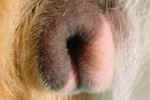
| | | | Male After Neuter
example 1 | | | | Surgical glue was used on the outer incisions (one on each side). Day after surgery: 

2nd day after surgery: 
| |  | Male Before Neuter
example 2 |  | | |
Intact male, about 1 year old.
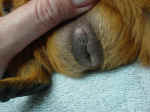
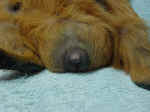
| | | | Male After Neuter
example 2 | | | | Surgical glue was used on the outer incisions (one on each side). Note the slight separation of the one incision. By the second day, this looks quite normal. However, it's important to keep the towels clean to avoid bacterial infection. Day after surgery: 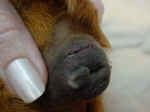
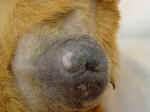
2nd day after surgery: 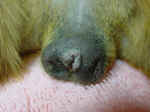
| |  | |  | Our Sponsors |  | | |
| |  |
|  |

